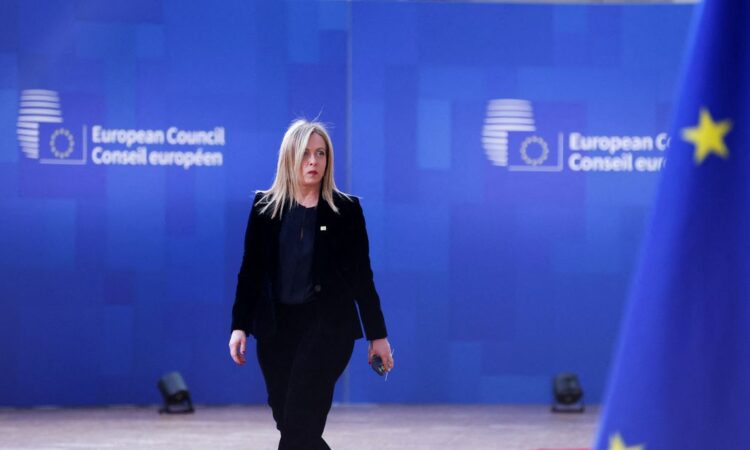
[1/2] Italian Prime Minister Giorgia Meloni attends the European Union leaders summit in Brussels, Belgium March 23, 2023. REUTERS/Johanna Geron/File Photo
ROME, May 24 (Reuters) – Italy, the biggest beneficiary of the EU’s 724 billion euro ($797 billion) post-pandemic recovery fund (RRF), is struggling to meet the goals laid down by Brussels to receive the money and is falling behind with implementation of its projects.
The EU Commission on Wednesday expressed concern over the delays and called on Italy to act swiftly to address its problems with the funding programme, which expires in 2026.
WHAT DOES ITALY WANT?
In 2021, the then-Prime Minister Mario Draghi, following a blueprint drawn up by his predecessor Giuseppe Conte, got the go-ahead from Brussels to receive 68.9 billion euros in grants and 122.6 billion euros in cheap loans for a total 191.5 billion euros — some 50 billion euros more than any other country.
His government presented an initial 138,640 projects which fell into six investment areas — digitalisation, ecological transition, infrastructure, education, social equality and health.
Italy has so far received a pre-financing package and two instalments of payments totalling 67 billion euros.
A third instalment for 19 billion euros was due at the end of 2022 but was frozen after the EU said it wanted clarification about Rome’s efforts to meet the “targets and milestones” needed to unlock the money. The government says it answered all the EU Commission’s questions and believes the cash will come shortly.
WHAT IS THE PROBLEM?
Prime Minister Giorgia Meloni, who took office last October, has said Russia’s invasion of Ukraine and high inflation mean that the original plan must be revised and has got the go-ahead from Brussels to put forward a revamped programme.
Speaking off the record, government officials say the original plan was deeply flawed, complaining that it was absurd to think Italy could spend so much money by the 2026 deadline, when it has one of the worst records for spending EU funds in recent decades. The government wants written guarantees that every RRF initiative will be completed on time. If not, they will be swapped out.
Local administrations are struggling to meet deadlines — a problem exacerbated by years of austerity which have left regions and municipalities short of qualified staff. Experts say a welter of micro projects is also snarling the system. A report by Milan’s Bocconi University says 76,000 of the projects are worth less than 70,000 euros each, and questioned whether they should be put to one side to free up administrators.
Government officials say the glut of projects is also creating a labour shortage, which risks delaying some of the large infrastructure projects beyond the 2026 cut-off point.
DOES THE NEW GOVERNMENT CARRY ANY BLAME?
Meloni changed how the RRF was overseen and put European Affairs Minister Raffaele Fitto in overall charge. He is still setting up his team and some key appointments have not yet been made. The shake-up has lost Italy valuable time. There is also a lack of transparency, with no update on the status of projects since the government took office.
Fitto has promised to present Brussels with a revised plan by the end of August, but critics say his review is taking too long, raising further doubts on whether the money can be spent by 2026.
The government says it cannot rush the review because it needs to present a definitive, watertight case to Brussels. One government official said undertakings made by previous administrations were unrealistic.
WHAT ARE THE OPTIONS?
The simplest thing would be to admit that Italy has bitten off more than it can chew, and scale back its RRF. However, ministers insist Italy will use up all the allotted money.
Business leaders have urged the government to redirect funds to the private sector in the form of tax breaks. In this vein, a senior official said this month that Rome was looking to invest part of the funds to help national firms with various schemes including the ecological renovation of industrial plants.
The government has also signalled it wants to use the RRF for new strategic energy projects, including building a link to bring gas and hydrogen produced in North Africa to Europe.
However, the EU says the RRF must be used for ecological transition, meaning it might not agree to such initiatives.
($1 = 0.9084 euros)
Additional reporting by Giuseppe Fonte; Editing by Edmund Blair
Our Standards: The Thomson Reuters Trust Principles.






